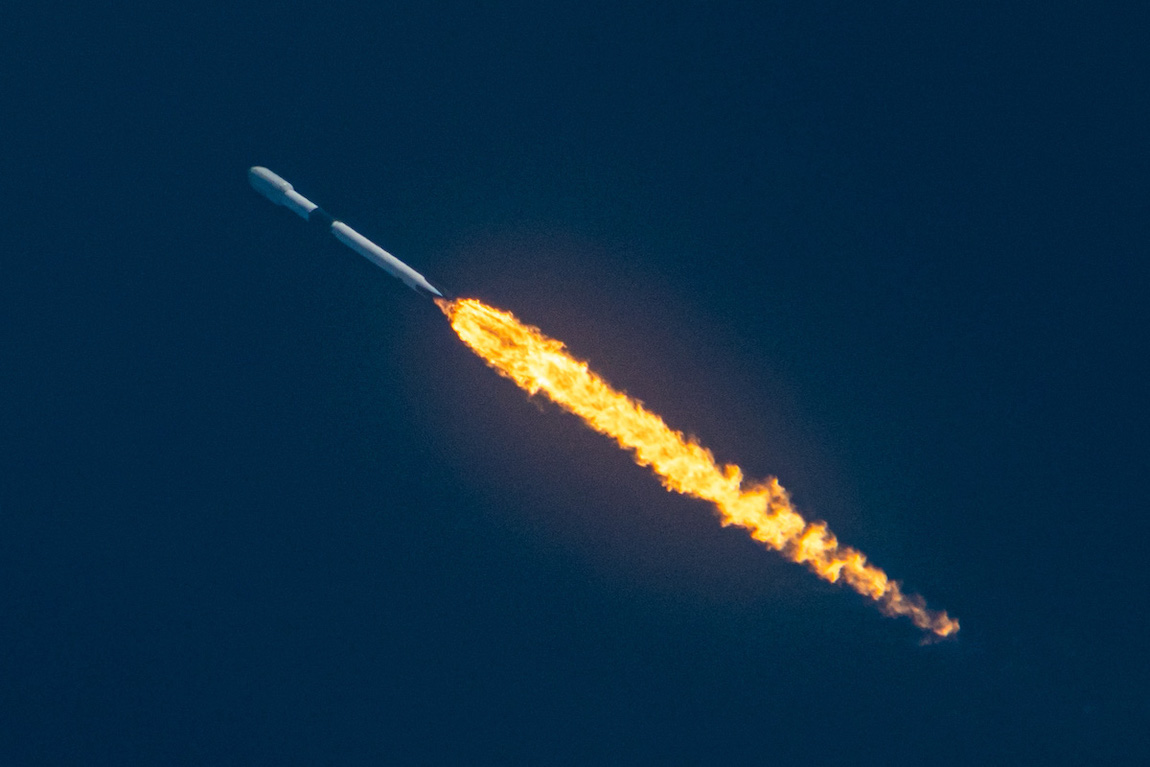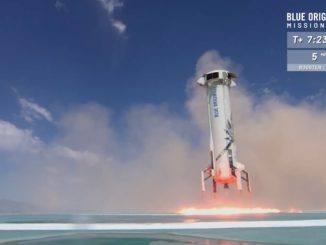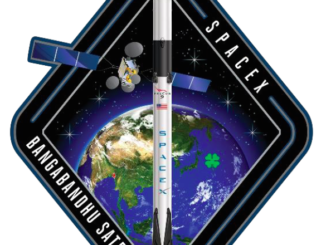
SES, the international communications satellite operator, plans to send two more C-band television broadcasting spacecraft into orbit from Cape Canaveral Friday night atop a SpaceX Falcon 9 rocket on a mission that will help clear spectrum for transition to 5G network services.
The SES 18 and SES 19 satellites are stacked one on top of the other inside the payload fairing of a Falcon 9 rocket set for liftoff during a 38-minute launch window opening at 7:38 p.m. EDT (2338 GMT) Friday, a few minutes after sunset on Florida’s Space Coast.
There is an 80% chance of good weather for launch of the Falcon 9 rocket Friday night. The main weather concern is with ground winds.
Heading east from pad 40 at Cape Canaveral Space Force Station, the nine-engine booster stage of the Falcon 9 rocket will return to Earth for landing on a drone ship a few hundred miles downrange in the Atlantic Ocean, while the upper stage will fire its single Merlin engine two times before deploying SES 18 and 19 one at a time 32 minutes and 37 minutes after liftoff.
The Falcon 9 will aim to release the two Northrop Grumman-built satellites into a “sub-synchronous” transfer orbit with an apogee, or high point, short of the satellites’ final 22,000-mile-high operating altitude in geostationary orbit.
In launch configuration, the two nearly identical satellites weigh 15,995 pounds (7,255 kilograms), according to a Northrop Grumman spokesperson. The lower satellite in the dual-payload stack, SES 19, weighs about 100 pounds more than the upper satellite because it carries structural components to directly connect the spacecraft together during the ride into orbit.
SES 18 and 19 will be the fourth and fifth new C-band communications satellites to join SES’s fleet in the last nine months. The flurry of new C-band satellite launches stem from a 2020 order for six new spacecraft, including a spare, as part of a Federal Communications Commission decision to clear 300 megahertz of C-band spectrum for the roll-out of 5G mobile connectivity networks.
The new C-band satellites will operate in a narrower swath of spectrum, enabling the broadcast of digital TV services to nearly 120 million homes in the United States, while clearing the 300 megahertz of spectrum now assigned for use by 5G operators.
The FCC auctioned U.S. C-band spectrum — previously used for satellite-based video broadcast services to millions of customers — to 5G operators, which are paying satellite operators like SES through multibillion-dollar compensation agreements. Intelsat, another large television broadcast satellite operator, ordered seven new C-band satellites as part of the C-band clearing initiative.
SES launched the first new C-band satellite, SES 22, on a Falcon 9 rocket last June. Two more C-band satellites, SES 20 and 21, launched in tandem on a United Launch Alliance Atlas 5 rocket in October. SES ordered a spare satellite, SES 23, that the company does not plan to launch, pending a successful deployment of SES 18 and 19 on the next SpaceX mission, an SES spokesperson said.
SES 18 and 19 will unfurl their solar panels and complete a series of post-launch checkouts, then use a hydrazine-fueled main engine to reshape its orbit from the elliptical, or oval-shaped, transfer orbit the Falcon 9 will put them in after Friday’s launch. The satellites will maneuver into circular geostationary orbits some 22,000 miles (nearly 36,000 kilometers) over the equator, where their speed will match the rate of Earth’s rotation, keeping them over the same location on the planet and providing a fixed coverage zone for their C-band broadcast antennas.
The new satellites, based on Northrop Grumman’s GEOStar satellite design, should be ready to begin commercial service in June to provide TV, radio, and data relay services across the United States. SES 18 will head for a position at 103 degrees west longitude, where it will replace the C-band payload on the SES 3 satellite launched in 2011. SES 19 will enter service at 135 degrees west longitude, co-located with the SES 22 satellite launched last year.

The Falcon 9 rocket assigned to loft the SES 18 and 19 satellites will be powered by a first stage booster, numbered B1069, making its sixth flight to space. The launch Friday night from Cape Canaveral is scheduled just four hours after another Falcon 9 rocket is set to blast off from Vandenberg Space Force Base in California.
The Falcon 9 flight from California is set to launch at 12:26 p.m. PDT (3:26 p.m. EDT; 1926 GMT), 4 hours and 12 minutes before the opening of the launch window for the Falcon 9 launch from Cape Canaveral.
If both missions launch as scheduled, it would set a new record for the shortest turnaround time between SpaceX Falcon 9 launches. The current record is 7 hours and 10 minutes, and was set last October with launches from Florida and California.
The back-to-back missions will be SpaceX’s 18th and 19th flights of the year, and 211th and 212th flights overall by a Falcon 9 rocket.
Email the author.
Follow Stephen Clark on Twitter: @StephenClark1.



